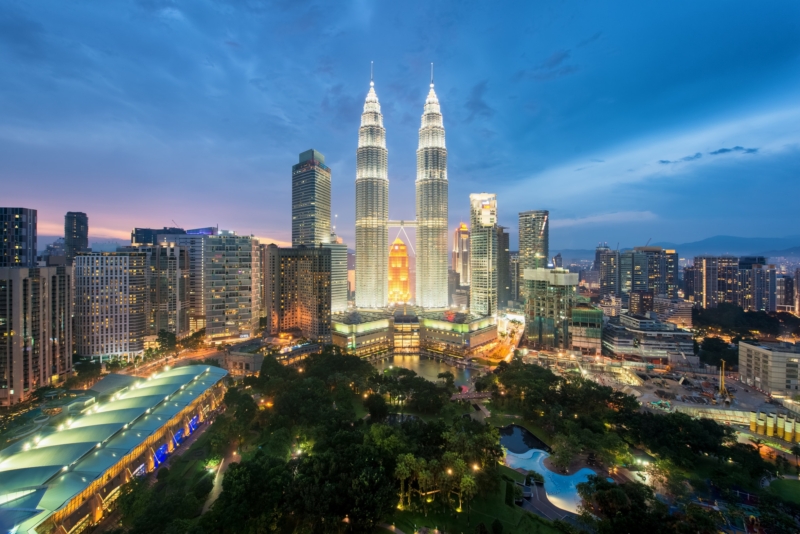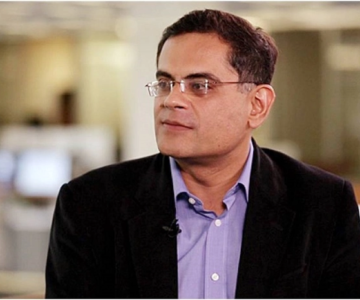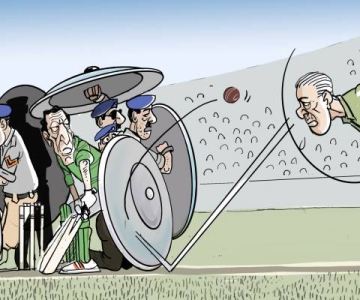“Muslim societies can learn from the plurality of race and religions in Malaysia” says Raza Rumi
A few days spent in Malaysia are enough to dispel many myths about Muslim intolerance that are projected and reinforced by Western media and pop culture. An economic miracle of the 1980s, branded as the Asian tiger and vision personified by the iron-man Mahathir, Malaysia is a heart-warming testament to plurality and co-existence within the Islamic framework. Malaysia’s 25 million strong population – modest by Pakistani standards – is a baffling mix of Malay, Chinese, Indian, Ibans and Kadazandusuns, among others.While the Malays constitute a marginal majority (over 50 per cent) of the total population and practice Islam quite seriously, the other groups enjoy full freedom to believe and live according to their own faiths.
Kuala Lumpur’s landscape is dotted with mosques, temples and churches and there seems to be little tension. Admittedly, economic progress over the last two decades underwrites much of this success; yet this cannot be attributed to economic reasons alone. Leadership has played a vital role in instilling the sense of national pride and vision among all the races and religions in Malaysia. The country gained independence a decade after Pakistan and was poorer than most developing countries, yet Mahathir’s twenty-year rule transformed the former British colony and increased levels of prosperity beyond belief. Its economic development aside, Malaysia’s recent cultural development carries important lessons for Muslim states and societies.
Surprisingly, little is said in the Muslim world about the Malaysian practice of Islam. Calls for levying jizya in Pakistan on non-Muslims are all too common. One only has to see how many Christian and other minority professionals have emigrated to the West to realise the loss of diversity and human capital that Pakistan has suffered. In Malaysia, the societal contributions of Christians, Buddhists and Hindus are accepted.
Don’t think that Malaysia doesn’t suffer communal tensions: The north-eastern Kelanten state – less developed and thus not enjoying the same fruits of economic progress as the rest of Malaysia – is ruled by Islamists. This particular state also has the reputation of being mercurial and changing governments frequently. Nevertheless, when I asked about the extremists’ chances of affecting the national political scene, almost all respondents – including sympathisers – said that it was not possible for “ages to come.”
Mahathir’s broad-based vision is often criticised for being too soft and too inclusive with respect to non-Muslims. In particular, the exegesis-led dream of carving a caliphate with a “hear no evil and see no evil” policy has not been possible for many purists in the country. But the cost of establishing a particularistic society in a melting pot of cultures, races and histories would be disastrous. Mahathir’s dream has, for the most part, been achieved with consensus, though also sometimes enforcement. Authoritarian apologists in Pakistan often ignore the fact that Mahathir’s authoritarianism earned its legitimacy through its delivery of the goods, and not just rhetoric disguising corporate interests.
Striking evidence of an atmosphere of cultural inclusion is reflected by the 16 million (yes, really!) tourists that visit Malaysia each year. The credit for this can go not only to Malaysia’s excellent infrastructure, but also its remarkably free and fair atmosphere. The ninth 5-year plan 2006-2010 predicts that the number of tourists will increase to 25 million. Currently, gross earnings from the tourism industry tot up to over $8.6 billion and the state promotes tourism as a top priority. Beach resorts attract the odd voices of lunacy that we are all too familiar with and are then subdued by the economic gains for the local population. Its campaign to market itself as exotic, with its complimentary catchy slogan ‘ Malaysia – truly Asia,’ works like a charm in the mind of even the Pakistani tourist.
Malaysia’s fusion cuisine reflects the country’s fascinating diversity. The local fried rice nasi goreng is made in various styles corresponding to the population mix – Malay, Chinese, Indian etc. Over time, Kuala Lumpur (KL) restaurants have improvised delightful menus that combine Malay and Indian recipes; the results are spectacular. The local radio channels play music, including Hindi film songs, according to the same formula. Bollywood fascination reigns supreme. Amir Khan is a celebrity and all the papers track his activities. During my visit, Saif Ali Khan underwent an urgent appendicitis operation in KL, which made the headlines for three days! Cultural vibrancy gets full expression through the performing arts and the number of local theatre productions performed in KL alone is mind boggling. From what little I saw of the local art scene, it seemed that art too was moulded in the cultural milieu. In just the one art gallery I visited, the range of styles, themes and techniques was amazing.
Of course there are problems, over and above the communal, that are yet to be resolved. The British system of administration has not been transformed and as a local observer noted, “the civil service is plagued by hierarchy, a generalist bias and sycophancy. It’s not that reform has not been undertaken. Much has been done, but there is still a long way to go.” In terms of corruption, the police department stands out in particular. According to a survey undertaken by the government in 2005, most Malaysians think that the police department is the most corrupt. The day I was leaving, the ‘lady’ Chief Judge – incidentally, Islam’s fortress, Pakistan, does not have a single woman in the superior courts now – spoke sternly against incidents of deaths in police custody and the fact that the police force is not fulfilling its statutory obligations.
The issue of women’s participation is often beaten to death, but as with all clichèd issues, it remains of the utmost importance. Most Malaysian – including the Muslim Malay – women work outside their homes. The civil service staff is almost 50 per cent women (though the same percentage is not evident in management positions) and women in hijabs are commonly seen in hotels working as waitresses or receptionists. Oddly enough, the local dress material is the same polyester-type material sold commonly in Pakistan’s barra markets. These modest yet equal participants in the country’s economic and political life go to the mosques and pray in the same room as men. I wonder how a certain maulvi I heard in Lahore would react, given his statement that the Almighty would not accept any prayers that a woman made outside the confines of her house.
Friday prayers in a KL mosque were reminiscent of the traditional adherence to all stages of the ritual. The difference, however, was that the Imam was using a laptop and flat screens to deliver the khutba in Malay and English – not to mention the innovative design of most of the new mosques. The big mosque in the official capital of Putra Jaya has an eclectic design where the domes of the mosque display, amongst others, Persian, Moorish and Southeast Asian influences. Putra mosques’ Islamic architecture artistically blends traditional designs, local craftsmanship and the use of indigenous materials.
However, not everyone shares the enthusiasm expressed by this scribe. Many Malaysians think that Malay hold over government, bureaucracy and other positions of power have rendered the minorities second class citizens. Malays hold the reins of power pretty firmly, while it is widely believed that the Chinese retain economic power and control over business. Further, Mahathir’s heavy-handed prosecution of his former deputy Anwar Ibrahim, charged with corruption and sodomy, has also left fissures within the polity. One of the men charged with having submitted to Ibrahim’s adventures was of Pakistani origin, Dr Munawar Anees, who was his friend and speech writer. Ibrahim was acquitted by courts that were desperate to preserve their image. Anwar Ibrahim is still popular and many Malaysians would like him to have a greater role in country’s future. Mahathir now lives in Putra Jaya and has, thankfully, set the precedent of stepping down with grace. The current leader Abdullah Bidawi is an old Mahathir loyalist and shares his vision for the modernisation of Malaysia. All in all, Malaysia is doing well at retaining cultural integration and inclusiveness – such processes have yet to start in many countries of the Islamic world.
An essential part of Mahathir’s vision was a state-of-the-art network of highways (that grant separate lanes to motorcyclists) and the improvement of public transport in the big cities. It is all there to be seen and marvelled at. The mall culture is fairly embedded in the consumer psyche. Several Malaysian malls, otherwise tributes to the naked goddess of consumerism, provide space to the small vendors who sell indigenous crafts and home-based produce and re-create the bazaar ambience. The local flavour and diversity makes these malls less offensive and crass than their counterparts in other countries, such as the USA.
The Perdana Leadership Foundation, inspired by his vision, is Dr Mahathir’s “retirement office.” The foundation has been involved in supporting national and international events on leadership and supports multiple research activities. Dr Mahathir, who is now honorary president of the foundation, also raises a lone voice for ijtiehad – that elusive enigma thwarted by prevalent dogma. I can’t help but quote a few excerpts from a recent speech delivered earlier this year:
“Unfortunately, for a long time, they closed the door on ishtihar ( ijtehad ). But it is not something wrong, it has been done before. Perhaps we should revive that discussion. . . today we see Shias blowing up Sunni mosques, Sunnis blowing up Shia mosques, we see a lot of antagonism between the different sects and yet they all claim to be Muslims . . . they consider different sects as not being Islamic. But if we go back to the fundamental teachings of Islam, then we eliminate the differences in interpretation; perhaps it would be easier for us to get along together, to be brothers and sisters in Islam. In that way I think we can be united, and of course unity is strength, and at the same time we can utilise the whole potential of the Muslims.”
Citing Christianity’s experience of reform, Dr Mahathir said: “They have Protestants, Catholics, they have Orthodox [Christians] . . . and the Catholics and Protestants have been known to fight it out in different small groups . . . In the past, they used to kill each other, they used to burn at the stakes because of differences in understanding and they tended to condemn others as heretics. But today, they are much more liberal. They don’t question each other on the interpretation of the religion. What has happened to the Muslim religion is the same. There is fragmentation due to different interpretations.”
Mahathir’s words are poignant. And I wonder, who will advance this vision in Pakistan’s messy population of millions of disparate, beleaguered and inward-looking souls.



